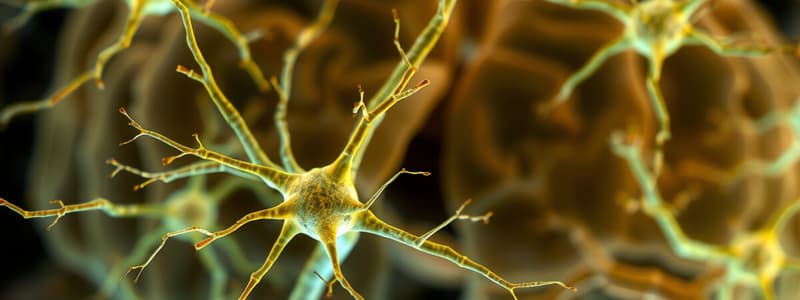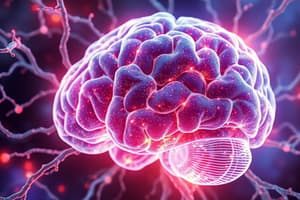Podcast
Questions and Answers
Which part of a neuron is responsible for receiving nerve impulses?
Which part of a neuron is responsible for receiving nerve impulses?
- Dendrites (correct)
- Soma
- Axon
- Myelin sheath
What is the primary function of neurons?
What is the primary function of neurons?
- To transmit information (correct)
- To support the immune system
- To facilitate digestion
- To produce hormones
What is the main distinction between motor neurons and sensory neurons?
What is the main distinction between motor neurons and sensory neurons?
- Motor neurons originate from the periphery, sensory neurons from the CNS
- Motor neurons transmit sensory impulses, sensory neurons do not
- Motor neurons have dendrites, sensory neurons do not
- Motor neurons have long axons; sensory neurons have axons with receptors (correct)
What are intrinsic neurons characterized by?
What are intrinsic neurons characterized by?
Which structure is found in both motor and sensory neurons but is differently organized?
Which structure is found in both motor and sensory neurons but is differently organized?
What type of neuron typically crosses to the opposite side of the body?
What type of neuron typically crosses to the opposite side of the body?
What aspect of neurons contributes to their functional diversity?
What aspect of neurons contributes to their functional diversity?
Which of the following sensory organs is NOT paired with its correct sense?
Which of the following sensory organs is NOT paired with its correct sense?
What is characteristic of unipolar neurons?
What is characteristic of unipolar neurons?
Which type of neuron is described as having a pyramid shape and is the largest neuron cell?
Which type of neuron is described as having a pyramid shape and is the largest neuron cell?
What defines a pseudo unipolar neuron?
What defines a pseudo unipolar neuron?
Which type of neuron primarily acts as inhibitory neurons with multiple dendrites?
Which type of neuron primarily acts as inhibitory neurons with multiple dendrites?
What is the typical cytoplasmic ratio of giant neurons?
What is the typical cytoplasmic ratio of giant neurons?
Study Notes
Glial Cells and Neurons Overview
- Neurons are the basic functional unit of the brain, primarily responsible for transmitting information.
- Mammalian brains contain approximately 100 billion neurons.
- Neurons interact with glial cells, which support and protect neurons.
Neuron Structure
- The neuron consists of a cell body (soma) that generates two types of cell processes:
- Dendrites: Receive nerve impulses from sensory cells or other neurons.
- Axon: Conveys signals to other cells.
- The soma contains essential organelles like the nucleus, endoplasmic reticulum, Golgi apparatus, and mitochondria.
Diversity in Neurons
- Neurons vary in size and shape, exemplified by:
- Pyramidal cells in the cerebral cortex.
- Purkinje cells in the cerebellar cortex.
- Olfactory cells in the olfactory epithelium.
Functional Classification of Neurons
- Interneurons: Connect different neurons within the CNS.
- Motor Neurons: Carry impulses from the CNS to effectors (muscles/glands).
- Sensory Neurons: Transmit sensory information from sensory organs to the CNS.
Motor and Sensory Neuron Differences
- Motor Neuron Characteristics:
- Long axons with multiple short dendrites.
- Cell body located at the terminal end.
- Sensory Neuron Characteristics:
- Short axon with receptor cells located alongside the soma.
- Typically lacks dendrites.
Neuron Projections
- Neurons can decussate (cross over) to the opposite side of the body or remain ipsilateral (on the same side).
Types of Neurons
-
Unipolar Neurons:
- Spherical soma with a single process that divides into two branches.
- Common in invertebrate interneurons.
-
Bipolar Neurons:
- Have one axonal and one dendritic process.
- Often involved in sensory functions.
-
Multipolar Neurons:
- Feature many dendritic processes and a single axon.
- Predominantly found in interneurons and motor neurons.
-
Pseudo-Unipolar Neurons:
- Possess a single process from the soma that branches into two distinct structures.
- Typical in sensory neurons, connecting to dendrites and transmitting information to the spinal cord.
Neuron Size and Structure
- Small Neurons: Diameter around 3 micrometers, with a nucleus to cytoplasm ratio close to 1; examples include globuli cells of invertebrates.
- Giant Neurons: Diameter can reach 1000 micrometers, with a nucleus to cytoplasm ratio of 0.5; examples include neurons found in marine gastropods.
Purkinje Neurons
- Found in the cerebellum, these inhibitory neurons have multiple dendrites and release neurotransmitters that prevent excessive neuronal firing.
Studying That Suits You
Use AI to generate personalized quizzes and flashcards to suit your learning preferences.
Description
Explore the fundamental components of the brain, focusing on glial cells and neurons. Understand their structure, functions, and how they transmit information. This quiz will test your knowledge on the basic workings of these essential brain units.



